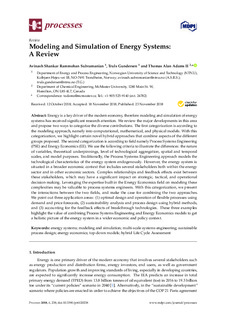| dc.contributor.author | Rammohan Subramanian, Avinash Shankar | |
| dc.contributor.author | Gundersen, Truls | |
| dc.contributor.author | Adams, Thomas Alan | |
| dc.date.accessioned | 2019-09-18T06:18:26Z | |
| dc.date.available | 2019-09-18T06:18:26Z | |
| dc.date.created | 2019-03-07T14:47:02Z | |
| dc.date.issued | 2018 | |
| dc.identifier.citation | Processes. 2018, 6:238 (12), 1-45. | nb_NO |
| dc.identifier.issn | 2227-9717 | |
| dc.identifier.uri | http://hdl.handle.net/11250/2617317 | |
| dc.description.abstract | Energy is a key driver of the modern economy, therefore modeling and simulation of energy systems has received significant research attention. We review the major developments in this area and propose two ways to categorize the diverse contributions. The first categorization is according to the modeling approach, namely into computational, mathematical, and physical models. With this categorization, we highlight certain novel hybrid approaches that combine aspects of the different groups proposed. The second categorization is according to field namely Process Systems Engineering (PSE) and Energy Economics (EE). We use the following criteria to illustrate the differences: the nature of variables, theoretical underpinnings, level of technological aggregation, spatial and temporal scales, and model purposes. Traditionally, the Process Systems Engineering approach models the technological characteristics of the energy system endogenously. However, the energy system is situated in a broader economic context that includes several stakeholders both within the energy sector and in other economic sectors. Complex relationships and feedback effects exist between these stakeholders, which may have a significant impact on strategic, tactical, and operational decision-making. Leveraging the expertise built in the Energy Economics field on modeling these complexities may be valuable to process systems engineers. With this categorization, we present the interactions between the two fields, and make the case for combining the two approaches. We point out three application areas: (1) optimal design and operation of flexible processes using demand and price forecasts, (2) sustainability analysis and process design using hybrid methods, and (3) accounting for the feedback effects of breakthrough technologies. These three examples highlight the value of combining Process Systems Engineering and Energy Economics models to get a holistic picture of the energy system in a wider economic and policy context. | nb_NO |
| dc.language.iso | eng | nb_NO |
| dc.publisher | MDPI | nb_NO |
| dc.rights | Navngivelse 4.0 Internasjonal | * |
| dc.rights.uri | http://creativecommons.org/licenses/by/4.0/deed.no | * |
| dc.title | Modeling and simulation of energy systems: A review | nb_NO |
| dc.type | Journal article | nb_NO |
| dc.type | Peer reviewed | nb_NO |
| dc.description.version | publishedVersion | nb_NO |
| dc.source.pagenumber | 1-45 | nb_NO |
| dc.source.volume | 6:238 | nb_NO |
| dc.source.journal | Processes | nb_NO |
| dc.source.issue | 12 | nb_NO |
| dc.identifier.doi | 10.3390/pr6120238 | |
| dc.identifier.cristin | 1682971 | |
| dc.relation.project | Norges forskningsråd: 257632 | nb_NO |
| dc.description.localcode | © 2018 by the authors. Licensee MDPI, Basel, Switzerland. This article is an open access article distributed under the terms and conditions of the Creative Commons Attribution (CC BY) license (http://creativecommons.org/licenses/by/4.0/). | nb_NO |
| cristin.unitcode | 194,64,25,0 | |
| cristin.unitname | Institutt for energi- og prosessteknikk | |
| cristin.ispublished | true | |
| cristin.fulltext | original | |
| cristin.qualitycode | 1 | |

